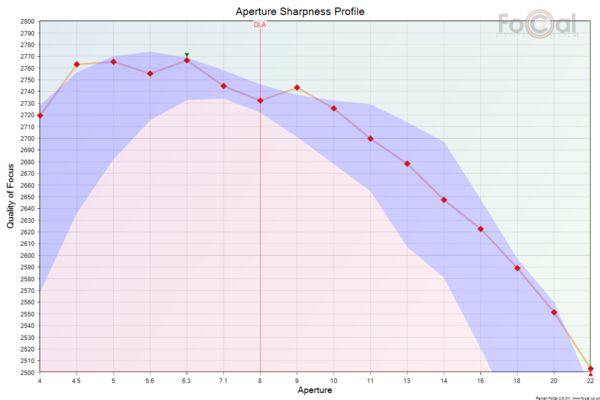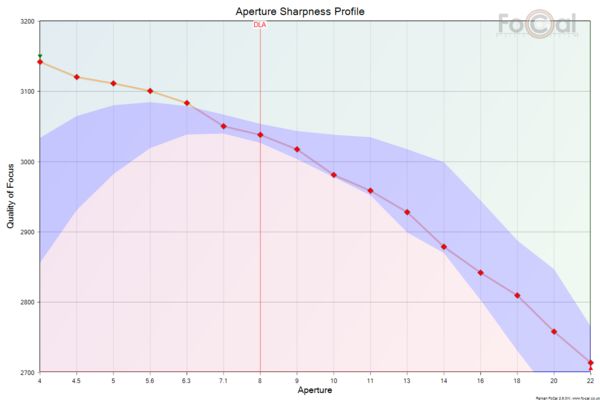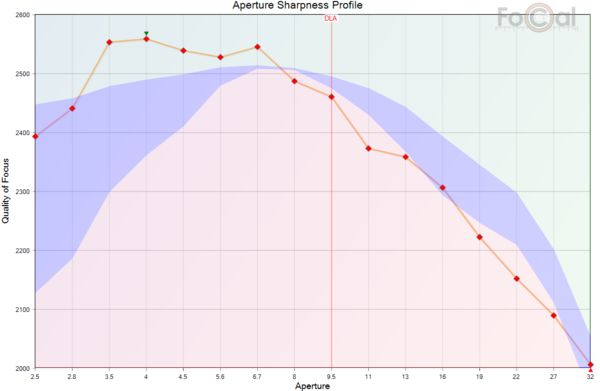Why use f11 or f16?
Apr 30, 2020 22:24:46 #
Apr 30, 2020 22:26:21 #
The sweet spot is usually closer to f/8 to f/11. It depends on how fast the lens is & the focal length.
Apr 30, 2020 22:31:32 #
kenArchi wrote:
Isn't f4 or f5.6 is where the lens is at it's sharpest?
A smaller aperture provides a greater depth of field. Diffraction is the potential problem with the smaller apertures, but depending upon the sensor and lens, and upon what the subject is and what results one is pursuing, the increased diffraction may be negligible and worth the trade off for the increased depth of field. I use f/16 more than any other aperture. Going to a larger aperture would not improve the shots I take. I use larger apertures only for artistic effects, intentionally going for a shallow depth of field.
Mike
Apr 30, 2020 22:34:11 #
nicksr1125 wrote:
The sweet spot is usually closer to f/8 to f/11. It depends on how fast the lens is & the focal length.
In practical use, it doesn't matter much which aperture is the "sweet spot." The photographer makes creative decisions about depth of field and diffraction. If that means using an aperture other than the "sweet spot" so be it.
Mike
Apr 30, 2020 22:41:59 #
Blenheim Orange wrote:
In practical use, it doesn't matter much which aperture is the "sweet spot." The photographer makes creative decisions about depth of field and diffraction. If that means using an aperture other than the "sweet spot" so be it.
Mike
Mike

Exactly what I do.
I have very good lenses and don’t give the “sweet spot” a thought.
I pick the aperture for the depth of field I want.
Apr 30, 2020 22:44:08 #
kenArchi wrote:
Isn't f4 or f5.6 is where the lens is at it's sharpest?
Depends on the lens. Most lenses hit their stride stopping down 2-3 stops from wide open. On a 50mm F1.4 lens it is already sharp at F4 in the center, it gets a little better at the corners and edges as you stop down a little more. A 600mmF4 is usually sharpest wide open. Some actually get worse at F5.6. My Sigma 150-600 Sport is best at F7.1 - F8. And so on . . .
It doesn't matter how good your lenses are, this is a simple fact, lenses have good apertures, and diffraction, which is always there, will start to be significant at F11 on low res full frame cameras, and already impacting sharpness at F5.6 on M4/3 cameras. Smaller sensor cameras don't even have mechanical apertures smaller than F5.6 or F8, resorting to internal neutral density filters to control exposure.
The sweet spot is really helpful when you are doing focus stacking - no point in going through the effort if you aren't using the best aperture to get the best sharpness. Also, particularly on fast lenses, lens flaws like field curvature, coma, chromatic aberration and other flaws are at their worst when the lens is wide open - whether you spend $100 or $4000 for a lens.
Some lenses are exceptional - like the Nikkor 105mm F1.4 - which is oustandingly sharp at all apertures until diffraction sets in at F8. The 200mm F2 is in the same company, also extremely sharp - it should be for $7000. But even it improves a bit at F5.6 over F2.
Now you can get some excellent results using F11, F16 and in some cases F22 - with certain subject matter - like macro. The reason is that your visual perception is seeing fine details magnified - even if those fine details aren't that fine. I guess what I am trying to say is that details that you look for when viewing an image at greater distances by moving up close you can see because the macro image is magnified, without the need to move in. So the image "appears" to be super sharp when in reality it is a little soft. But the perception of sharpness is informed by the unusual amount of magnified detail that you would have to move up close to see. Not sure if my choice of words is making the point.
Ignoring the sweet spot is a bit like leaving money on the table in a business transaction. No point in getting the best lenses if you are not using the best apertures for the best image quality whenever possible - creativity with depth of field aside for a moment.
Apr 30, 2020 22:46:00 #
It depends on the lens and the sensor size (camera format).
Keep in mind there are also esthetic considerations like DOF.
Keep in mind there are also esthetic considerations like DOF.
Apr 30, 2020 22:46:56 #
GoofyNewfie wrote:
Exactly what I do.
I have very good lenses and don’t give the “sweet spot” a thought.
I pick the aperture for the depth of field I want.

Exactly what I do.
I have very good lenses and don’t give the “sweet spot” a thought.
I pick the aperture for the depth of field I want.



Apr 30, 2020 22:57:38 #
Gene is correct (as usual) - it’s entirely dependent on the lens. I run a acutance vs aperture curves on all my lenses, and when you see those results, the effects of diffraction are very apparent. Here are a couple of curves for different lenses to illustrate - every one shows substantial diffraction loss beyond f11, and f8 is generally better. F16 will cost you on average 10% of the acutance you paid for, but if you need the DOF or can’t focus stack, then you may have to accept the degradation.



Apr 30, 2020 23:08:31 #
If you want to use a particular shutter speed value, sometimes f/11 or f/16 is the only way to achieve that goal. Sharpness isn't everything! Unless all you are interested in is taking pictures of lens test charts.
Apr 30, 2020 23:09:38 #
kenArchi wrote:
Isn't f4 or f5.6 is where the lens is at it's sharpest?
Not as a general rule.
Apr 30, 2020 23:43:53 #
Charts and theories aside, there is no such thing as a bad photograph as a result of not using the "sweet spot" of the lens. It is the images that matter, not the technical specs of the lens, and diffraction is but one issue we are dealing with. Wider apertures are simply not appropriate for many types of photography.
Mike
Mike
May 1, 2020 00:01:18 #
May 1, 2020 01:24:54 #
kenArchi wrote:
Isn't f4 or f5.6 is where the lens is at it's sharpest?
In most lenses its around 5.6 or 8 (ballpark), but its different for each lens!
May 1, 2020 02:38:38 #
Harry0
Loc: Gardena, Cal
RichardTaylor wrote:
It depends on the lens and the sensor size (camera format).
Keep in mind there are also esthetic considerations like DOF.
Keep in mind there are also esthetic considerations like DOF.
I agree.
If you're shooting a 6"x5" negative, f16 can be the size pf a pencil.
Compared to a aps, or m4/3 sensor, you may be looking at a tiny pinhole.
Which means a greater percentage of the open area contributes diffraction anomalies
Then again, a little fuzziness at the borders and corners isn't always a bad thing...
And I do shoot test charts.
My old Nikon lenses usually shoot the best @ f8, maybe f11.
My new-ish Tamron? F5.6
If you want to reply, then register here. Registration is free and your account is created instantly, so you can post right away.






